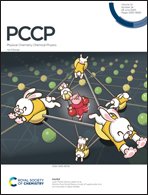Dehydrogenation of ethanol to acetaldehyde with nitrous oxide over the metal–organic framework NU-1000: a density functional theory study†
Abstract
The conversion of ethanol to more valuable hydrocarbon compounds receives great attention in chemical industries because it could diminish the dependency on petroleum as raw material. We investigate the catalytic performance of Fe-supported MOF NU-1000 for the dehydrogenation of ethanol to acetaldehyde with nitrous oxide (N2O) by deriving the relevant reaction profiles with density functional theory calculations. In the proposed mechanism, the activation barrier of the rate-determining step is almost four times lower in the presence of N2O than without it. The supported NU-1000 framework plays also important role since it facilitates electron transfers and stabilizes all species along the reaction coordinate. When considering the catalytic activity of tetravalent metal centers (Zr, Hf and Ti) substituted into NU-1000 it is found that their activity decreases in the order Hf ≥ Zr > Ti, based on activation energies and turnover frequencies (TOF). Concerning MOF linkers, we show that the catalytic activity is not further improved by functionalizing NU-1000 with either electron-donating or electron-withdrawing organic groups.



 Please wait while we load your content...
Please wait while we load your content...